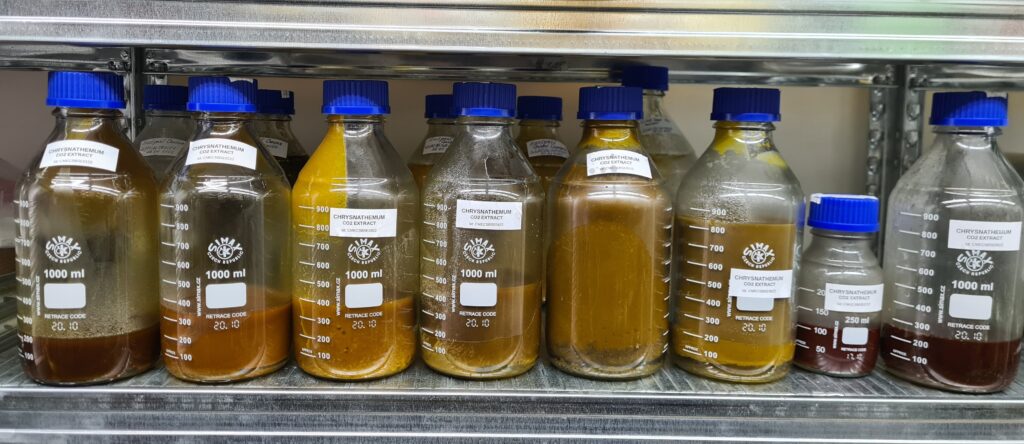InnCoCells is now at the half way stage!
We have selected the most promising plants, cells and root cultures, optimized their growth and metabolic activity at the laboratory scale, and we are now scaling them up and optimizing the extraction methods so that more ingredients can be tested for biological activity as we move our first ingredients to the pre-commercial phase
Image credit: lychees by B. Navez (CC BY-SA 4.0)
Progress after 24 months - upstream production
The EU-funded InnCoCells project has continued to make significant progress during the first two years. In the technical work packages for upstream production, we have delivered more than 60 new lines of plants and plant cells/tissues that have been investigated for their growth properties in different cultivation and production systems (bioreactors, aeroponic units, and open fields). Lines with the most promising growth properties have been assessed for their ability to produce bioactive cosmetic ingredients. The picture below shows starting plant material and callus cultures derived from basil (BA), perilla (PE) and sugar beet (BR), with different colors due to the accumulation of different metabolites (image credit: ENEA).
More than 20 cell suspension cultures have been optimized for growth in the light and dark at the laboratory scale, six of which have been scaled up to 30–40 L and two to more than 500 L. Furthermore, the production process for hairy root biomass was improved by eliminating bottlenecks in the seed train, leading to four runs at the technical scale (30 L) for the basil hairy root line and one at 300 L. Optimal growth conditions were identified for four plants in aeroponic units, two of which (Pogostemon cablin and Mentha aquatica) are currently growing on a surface of 100 square meters. Large-scale fields of chrysanthemum, geranium and lilac have also been established successfully. We are currently developing physical, metabolic and genetic tools to engineer the leading plant species in order to boost biomass production and the synthesis of bioactive metabolites at the same time (in contrast to wild-growing plants, which tend to prioritize one or the other).
The picture below shows a 300-L stirred-tank reactor containing a plant cell suspension culture (image credit: LIST).
Progress after 24 months - downstream processing and testing
In the technical work packages for downstream processing and ingredient testing, we have tested the extraction of active compounds from different plants on a small scale in order optimize the processing parameters, including pre-treatment with either enzymes or physical methods such as pulsed electric fields. We have confirmed the stability and concentration of the target compounds in these extracts prior to detailed chemical profiling. The picture below shows different lipophilic (soluble in oil) extracts of chrysanthemum prepared using the supercritical and subcritical carbon dioxide methods (image credit: Ecomaat).
More than 15 cell lines have been analyzed in exquisite detail, including basil, perilla, various pepper varieties and thistle species. We have also characterized byproducts from the processing of ginger, chicory and olive, among others, in order to evaluate their potential for the production of bioactive molecules. We have detected antimicrobial and collagen-promoting activities in several of the extracts. The picture below shows a volcano plot indicating the many bioactive molecules produced by pepper plants and highlighting the differences between pepper varieties. Metabolites that are more abundant in pimento peppers are shown on the left, and those more abundant in scorpion peppers are shown on the right (image credit: ENEA).
Dissemination, communication and exploitation
Finally, in the non-technical work packages focusing on the dissemination of our results, their exploitation and future commercialization, and communication with stakeholders, we have completed the documentation required for life cycle analysis and techno-economic evaluation, which will help us to provide concrete data on the sustainability of our cosmetic ingredients. We have also collected technical and regulatory data for the first InnCoCells ingredient ready to be launched, and we have carried out a survey to determine trends in the expectations of people who buy and use cosmetic products. We have presented our data in scientific articles, at conferences and exhibitions, as well as providing information about the project to our broad Stakeholder Group representing the cosmetic industry, the research community, and consumers. We have also continued to provide information about the project in the form of brochures, podcasts, videos, updates here on our website and social media, training sessions for professionals and webinars targeting a broader audience, and in our collaboration with the AIMS project cluster.





